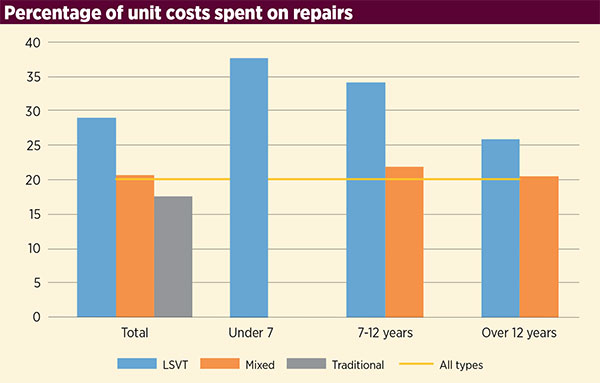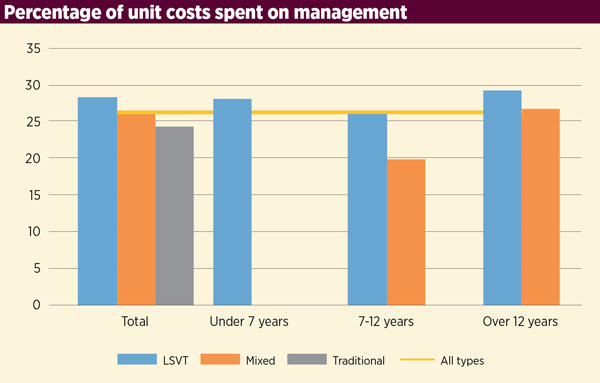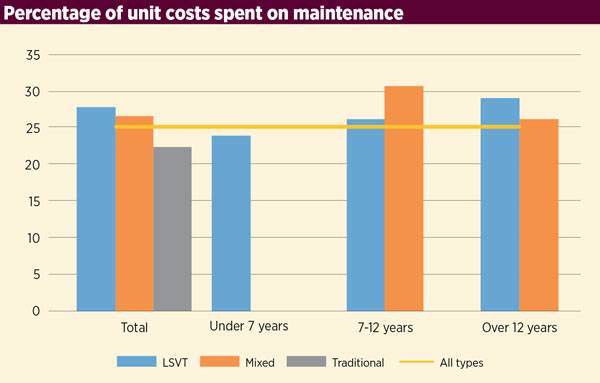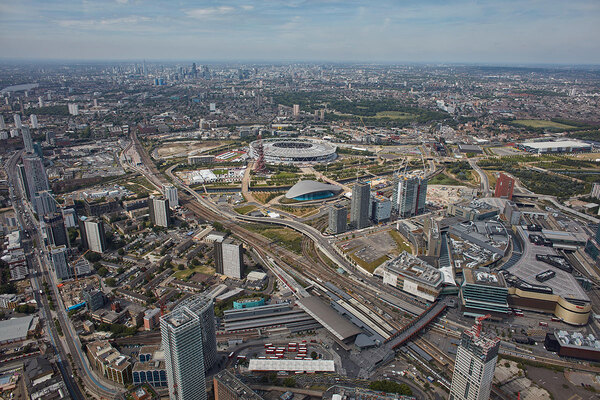Analysis: housing association unit costs explained
Stock transfer age, region and levels of supported and older people’s housing help to explain cost variation.
Social housing has running and repairs costs of an average of £3,960 per property, according to data published by the Homes and Communities Agency (HCA).
The analysis, published in February 2017, outlines the unit costs of individual housing associations in England using data from the 2015/16 Global Accounts and 2016 Statistical Data Return to work out the management, service charge, maintenance, major repairs and other costs.
The first version of the costs analysis came out in June 2016.
Social Housing has looked at the consolidated group level unit cost data published by the HCA and broken it down into the provider types set out by the agency.
These are large-scale voluntary transfers (LSVTs), traditional associations where none of the group is a stock transfer, and mixed groups that contain a mix of transfer and traditional associations.
Additionally, the LSVTs are divided into organisations that transferred less than seven years ago, between seven and 12 years ago, and more than 12 years previously, in order to reflect their differing costs as they mature. The mixed groups are divided into those where the main transfer took place seven to 12 years ago and more than 12 years previously for the same reason.
This report has not grouped organisations by the percentage of supported or older people’s housing they possess, as the HCA found no threshold below which the additional costs of these types of housing cease to be significant.
Stock transfer age, region, supported and older people’s housing, deprivation and the decent homes standard explain half of cost variation.
However, this report includes the percentages in the table with a narrative explanation, as they add the greatest amount of additional cost. Each association’s principal region is also included, as stated by the HCA. The report also includes totals for each type of organisation – traditional associations and the various age groups of LSVTs and mixed groups – and graphs of the percentage of unit costs that went towards repairs, management and maintenance.
Related Files
Key drivers of cost
The HCA found half the variation in costs could be explained by seven key factors such as the age of stock transfers, regional wages, percentage of stock that is supported or older people’s housing, neighbourhood deprivation and, in a small minority of cases, bringing properties up to the decent homes standard.
But the other half could not be explained by observable factors, the agency said. In some cases that is because there is no readily available data, such as information on stock condition, and in others it could be due to variations in efficiency.
The HCA said it uses the data as a tool for discussion in its in-depth assessments (IDAs) and stability checks; those associations with relatively high costs will be asked why, whether it is a conscious decision and, if not, how they plan to reduce costs or improve services. Supported housing had the greatest effect on costs of the seven factors outlined by the HCA.
Each unit of supported housing was associated with costs of £10,800 above general needs properties. However, the actual additional cost can vary between £8,400 and £14,000 because the client group and level of service provided will make a difference.
Housing for older people adds to unit costs, although to a lesser degree than supported housing. Each unit is associated with a cost of £1,800 above general needs units. Again, service levels vary widely from intensive support, similar to care homes, to properties that offer little more support than general needs properties.
Regional wage differences also influence costs with the HCA estimating that providers in London have average costs per unit of £1,900 above those in the North East.
But the agency added that this figure is heavily influenced by the effect of supported housing, which is often more labour intensive.
England unit costs
| RP type | Number of RPs | Social housing units managed | Headline social housing cost | Headline social housing costs per unit | Management CPU | Service charge CPU | Maintenance CPU | Major repairs CPU | Other social housing costs CPU | Supported housing (excl. HOP) | Housing for older people |
|---|---|---|---|---|---|---|---|---|---|---|---|
| total LSVT | 107 | 962,883 | 3,350,382 | 3.48 | 0.99 | 0.27 | 0.98 | 1.03 | 0.22 | 1.49% | 11.08% |
| total LSVT < 7 years | 9 | 85,100 | 365,632 | 4.30 | 1.21 | 0.24 | 1.03 | 1.63 | 0.18 | 0.69% | 9.31% |
| total LSVT 7-12 years | 27 | 204,686 | 751,410 | 3.67 | 0.96 | 0.26 | 0.97 | 1.28 | 0.21 | 1.47% | 8.41% |
| total LSVTs > 12 years | 71 | 673,097 | 2,233,340 | 3.32 | 0.97 | 0.28 | 0.97 | 0.87 | 0.22 | 1.60% | 12.32% |
| total mixed | 27 | 675,280 | 2,648,305 | 3.92 | 1.03 | 0.45 | 1.04 | 0.88 | 0.52 | 4.55% | 9.43% |
| total mixed 7-12 years | 6 | 54,736 | 180,700 | 3.30 | 0.66 | 0.43 | 1.02 | 0.78 | 0.42 | 4.23% | 12.29% |
| total mixed > 12 years | 21 | 620,544 | 2,467,605 | 3.98 | 1.06 | 0.46 | 1.05 | 0.88 | 0.53 | 4.65% | 8.62% |
| total traditionals | 106 | 1,106,622 | 4,868,583 | 4.40 | 1.08 | 0.80 | 0.99 | 0.74 | 0.79 | 9.35% | 14.76% |
| Total | 240 | 2,744,785 | 10,867,270 | 3.96 | 1.04 | 0.53 | 1.00 | 0.88 | 0.52 | 5.30% | 12.52% |
Traditional associations
As mentioned, the proportion of homes that are supported housing or housing for older people is the factor that has the most significant impact on costs.
Many traditional associations specialise in support or older people’s housing. Therefore, traditional associations have a much higher average percentage of supported housing – 9.35 per cent – than the average across all associations, which is 5.3 per cent.
Similarly, traditional associations have a higher average percentage of housing for older people. Indeed, the three traditional associations with the highest unit costs are care and older people’s specialists and two of these are based in London, the most expensive region.
The associations with the highest proportions of supported housing – which has the greatest effect on unit costs – were clustered at the upper end of the unit costs table.
St Mungo’s, for instance, which had the highest unit costs out of the traditional associations, works in London with homeless people, including those with more complex needs.
Sonia Smith, executive director of finance at St Mungo’s, said the organisation provides services such as one-to-one key-working for higher needs residents, which she said were not comparable with those of other registered providers.
She added: ‘Unlike other housing associations, our clients may stay with us for a relatively short time as they start to rebuild their lives and move on into longer-term, more appropriate housing. In addition, the majority of our clients have significant support needs in relation to their mental and physical health or substance use.’
The organisation has also begun major improvements to its housing and is looking at other ways of reducing its overheads.
Associations with more than 20 per cent housing for older people – which has a significant effect on costs but not as great as supported housing – are slightly more spread across the unit costs spectrum, but the majority are still within the top 50 by cost.
LSVT unit costs
| RP type | Social housing units managed | Headline social housing cost | Headline social housing costs per unit | Management CPU | Service charge CPU | Maintenance CPU | Major repairs CPU | Other social housing costs CPU | % Supported housing (excl. HOP) | % Housing for older people | Region with 50% of social stock owned |
|---|---|---|---|---|---|---|---|---|---|---|---|
| LSVT under 7 years | |||||||||||
| Byker | 1,783 | 11,767 | 6.60 | 1.22 | 1.45 | 1.14 | 2.65 | 0.14 | 3.53% | 0 % | North East |
| Red Kite | 5,911 | 32,980 | 5.58 | 1.15 | 0.31 | 0.89 | 3.49 | -0.25 | 0 % | 30.91% | South East |
| Salix | 8,446 | 44,583 | 5.28 | 1.24 | 0.22 | 1.48 | 1.47 | 0.86 | 1.28% | 3.94% | North West |
| First Choice Oldham | 11,664 | 52,374 | 4.49 | 1.04 | 0.24 | 0.83 | 2.26 | 0.11 | 0 % | 2.01% | North West |
| Gloucester City | 4,517 | 20,119 | 4.45 | 1.66 | 0.30 | 0.89 | 1.49 | 0.11 | 0.62% | 10.53% | South West |
| South Lakes | 3,107 | 13,764 | 4.43 | 1.14 | 0.22 | 0.94 | 2.03 | 0.10 | 0 % | 14.14% | North West |
| Rochdale BH | 13,477 | 55,728 | 4.14 | 1.23 | 0.32 | 0.85 | 1.59 | 0.14 | 0 % | 7.08% | North West |
| Bolton at Home | 17,924 | 72,969 | 4.07 | 1.42 | 0.24 | 1.20 | 0.90 | 0.32 | 0.73% | 15.20% | North West |
| County Durham | 18,271 | 61,348 | 3.36 | 0.98 | 0.05 | 1.01 | 1.31 | 0 | 0 % | 0 % | North East |
| RP type | Social housing units managed | Headline social housing cost | Headline social housing costs per unit | Management CPU | Service charge CPU | Maintenance CPU | Major repairs CPU | Other social housing costs CPU | % Supported housing (excl. HOP) | % Housing for older people | Region with 50% of social stock owned |
|---|---|---|---|---|---|---|---|---|---|---|---|
| LSVT 7 to 12 years | |||||||||||
| Highest cost per unit | |||||||||||
| East End Homes | 3,720 | 24,516 | 6.59 | 0.53 | 1.08 | 1.24 | 3.74 | 0 | 0 % | 0 % | London |
| Phoenix Community | 5,369 | 28,119 | 5.24 | 0.93 | 0.73 | 1.41 | 1.85 | 0.31 | 0 % | 0 % | London |
| Plymouth | 14,285 | 67,622 | 4.73 | 0.56 | 0.27 | 1.07 | 2.53 | 0.30 | 11.80% | 0 % | South West |
| Thrive | 4,274 | 18,985 | 4.44 | 1.61 | 0.46 | 1.15 | 1.03 | 0.20 | 0 % | 15.40% | East of England |
| ForViva | 17,550 | 76,238 | 4.34 | 1.25 | 0.19 | 1.12 | 1.68 | 0.11 | 5.19% | 1.78% | North West |
| Lowest cost per unit | |||||||||||
| Ongo | 9,724 | 22,343 | 2.30 | 0.52 | 0.04 | 0.82 | 0.82 | 0.09 | 0.08% | 4.94% | Yorkshire & the Humber |
| Southway (Manchester) | 5,850 | 14,867 | 2.54 | 1.03 | 0.04 | 0.70 | 0.36 | 0.41 | 0 % | 0.80% | North West |
| Livin | 8,480 | 22,734 | 2.68 | 0.98 | 0 | 0.91 | 0.64 | 0.15 | 0 % | 32.56% | North East |
| Community Gateway | 6,183 | 17,720 | 2.87 | 1.21 | 0.21 | 0.76 | 0.47 | 0.21 | 0.29% | 6.81% | North West |
| Victory | 4,969 | 14,286 | 2.88 | 0.75 | 0.23 | 0.94 | 0.90 | 0.06 | 0.28% | 8.93% | East of England |
| RP type | Social housing units managed | Headline social housing cost | Headline social housing costs per unit | Management CPU | Service charge CPU | Maintenance CPU | Major repairs CPU | Other social housing costs CPU | % Supported housing (excl. HOP) | % Housing for older people | Region with 50% of social stock owned |
|---|---|---|---|---|---|---|---|---|---|---|---|
| LSVTs over 12 years | |||||||||||
| Highest cost per unit | |||||||||||
| Watmos | 2,659 | 14,722 | 5.54 | 1.92 | 0.62 | 1 | 1.80 | 0.20 | 0 % | 0 % | West Midlands |
| Paragon | 7,622 | 39,696 | 5.21 | 1.96 | 0.58 | 1.70 | 0.72 | 0.25 | 2.77% | 14.24% | South East |
| Rosebery | 2,244 | 9,978 | 4.45 | 2 | 0.44 | 1.21 | 0.45 | 0.35 | 7.52% | 8.04% | South East |
| Trafford | 8,814 | 38,234 | 4.34 | 1.32 | 0.45 | 0.81 | 1.34 | 0.42 | 0.23% | 28.66% | North West |
| Raven | 5,594 | 23,927 | 4.28 | 0.91 | 0.41 | 1.31 | 0.96 | 0.69 | 1.61% | 6.40% | South East |
| Lowest cost per unit | |||||||||||
| Empowering People Inspiring Communities | 1,044 | 2,319 | 2.22 | 1.21 | 0.12 | 0.34 | 0.55 | 0 | 0.86% | 0 % | West Midlands |
| Luminus | 6,617 | 15,827 | 2.39 | 0.65 | 0.51 | 0.71 | 0.48 | 0.04 | 1.48% | 7.28% | East of England |
| Ocean | 4,425 | 11,047 | 2.50 | 1.16 | 0.16 | 0.67 | 0.51 | 0 | 0.33% | 17.48% | South West |
| Saffron | 5,731 | 15,029 | 2.62 | 0.44 | 0.19 | 1.18 | 0.63 | 0.18 | 2.71% | 11.97% | East of England |
| North Hertfordshire | 11,983 | 31,964 | 2.67 | 0.75 | 0.45 | 0.64 | 0.60 | 0.23 | 1.92% | 9.35% | East of England |
The HCA’s report on unit costs said the higher management and service charges of traditional associations could be explained somewhat by the greater proportion of supported and housing for older people units that they hold.
Among the traditional associations, 16 of the 30 with the highest unit costs are in London.
The HCA accepts that there are factors such as stock condition which it could not factor into the analysis because there are no readily available datasets.
The issue of stock condition and stock type was raised by Shepherds Bush Housing Association, which was in the 15 traditional associations with the highest unit costs.
A spokesperson said the HA has a high proportion of Victorian stock, which has higher investment costs. She added that the HCA had included the association’s temporary accommodation portfolio in the calculations, which the association did not treat as social housing.
It said that deducting this brings the cost to under £5,000 per unit, and with the reduction of other social housing costs to under £1,000 per unit. Additionally, the association is in one of the most expensive areas of London, she added.
Chapter 1 has undergone some changes since the unit costs report was published, merging with the Salvation Army Housing Association. That followed the social housing regulator giving Chapter 1 the lowest G4 rating for governance, and non-compliant V3 for viability.
Asked about its costs, Nigel Hills, finance director at Salvation Army HA, pointed out that Chapter 1 transferred half of its leased stock, which were private sector leased properties. The remainder of its stock was supported housing and was absorbed by the larger group in March 2017, he said.
A spokesperson for Peabody said some of the organisation’s stock is 19th century and in central London, which are factors that increase maintenance and staff costs. It also has an improvement programme – Quality Homes –
which means it will invest £2,430 per home. He said it was always looking to improve its efficiency to provide better services and maximise new development capacity.
The HCA categorises Genesis as a traditional association. It was among the top 15 traditional associations by unit cost.
Genesis said the HCA’s methodology includes the costs it incurs providing care and support in properties it does not own and through temporary housing, but does not take account of the fact that it is paid to provide these services and so recovers the costs.
Elizabeth Froude, deputy chief executive and group resources director, said almost 35 per cent of Genesis’ non-sales income comes from temporary housing and care and support, which are ‘low margin business streams we undertake as part of our core social purposes’. It means the general needs margin of 42 per cent ‘is then diluted as a blended margin’. Ms Froude added that Genesis has remained committed to a five-year strategy of investment in the standards of existing properties, increasing investment spend in 2016 by 31 per cent year-on-year, ‘while many registered providers have contracted expenditure to offset the rent reductions’. She pointed out that G15 expenditure grew by 0.3 per cent.
Mixed groups unit costs
| RP type | Social housing units managed | Headline social housing cost | Headline social housing costs per unit | Management CPU | Service charge CPU | Maintenance CPU | Major repairs CPU | Other social housing costs CPU | % Supported housing (excl. HOP) | % Housing for older people | Region with 50% of social stock owned |
|---|---|---|---|---|---|---|---|---|---|---|---|
| Mixed: 7-12 years since transfer | |||||||||||
| Four | 5,068 | 21,471 | 4.24 | 0.74 | 0.32 | 1.06 | 1.15 | 0.96 | 6.85% | 4.15% | North East |
| Westward | 7,142 | 29,076 | 4.07 | 0.85 | 0.47 | 0.81 | 1.38 | 0.56 | 6.56% | 16.97% | South West |
| Bernicia | 8,199 | 28,961 | 3.53 | 0.48 | 0.58 | 0.89 | 1.27 | 0.31 | 0.75% | 32.73% | North East |
| ISOS | 16,672 | 52,984 | 3.18 | 0.65 | 0.41 | 1.20 | 0.65 | 0.27 | 2.91% | 6.88% | North East |
| Adactus | 12,785 | 35,025 | 2.74 | 0.57 | 0.44 | 0.93 | 0.31 | 0.48 | 2.90% | 10.27% | North West |
| Mosscare | 4,870 | 13,183 | 2.71 | 0.83 | 0.28 | 1.05 | 0.38 | 0.17 | 5.40% | 2.76% | North West |
| RP type | Social housing units managed | Headline social housing cost | Headline social housing costs per unit | Management CPU | Service charge CPU | Maintenance CPU | Major repairs CPU | Other social housing costs CPU | % Supported housing (excl. HOP) | % Housing for older people | Region with 50% of social stock owned |
|---|---|---|---|---|---|---|---|---|---|---|---|
| Mixed: over 12 years since transfers | |||||||||||
| Highest cost per unit | |||||||||||
| Family Mosaic | 24,878 | 171,289 | 6.89 | 1.32 | 0.51 | 1.83 | 1.42 | 1.81 | 11.06% | 2.18% | London |
| Peabody | 24,598 | 132,792 | 5.40 | 1.32 | 0.43 | 1.56 | 2.09 | 0 | 1.36% | 1.96% | London |
| Network | 19,154 | 100,460 | 5.24 | 1.53 | 0.68 | 0.79 | 1.08 | 1.17 | 2.91% | 7.92% | London |
| Progress | 9,341 | 46,766 | 5.01 | 0.97 | 1.07 | 1.29 | 1 | 0.68 | 35.22% | 14.20% | North West |
| Metropolitan | 31,376 | 138,634 | 4.42 | 1.48 | 0.88 | 0.88 | 0.73 | 0.45 | 7.30% | 10.70% | London |
| Lowest cost per unit | |||||||||||
| Waterloo | 18,972 | 38,386 | 2.02 | 0.49 | 0.32 | 0.68 | 0.39 | 0.14 | 1.02% | 8.31% | East Midlands |
| Longhurst | 18,690 | 60,419 | 3.23 | 0.89 | 0.50 | 0.85 | 0.63 | 0.37 | 1.31% | 11.02% | East Midlands |
| Accent | 19,869 | 64,314 | 3.24 | 0.66 | 0.40 | 1.26 | 0.63 | 0.29 | 2.50% | 13.82% | Mixed |
| Incommunities | 21,562 | 70,972 | 3.29 | 1.14 | 0.17 | 1.10 | 0.71 | 0.17 | 0.54% | 4.41% | Yorkshire & the Humber |
| Hyde | 48,207 | 161,170 | 3.34 | 0.62 | 0.42 | 0.65 | 0.55 | 1.10 | 4.84% | 3.50% | South East |
LSVTs
The HCA found that new stock transfers have extra costs. It said stock transfers have an extra cost of £1,500 per unit above traditional associations in the first year to six years after transfer. The gap decreases to £300 per unit from year seven to 11 and disappears after 12 years.
The HCA also found that LSVTs have significantly higher maintenance and major repairs costs on average, and lower management and service costs than traditional providers.
LSVTs often spend significant amounts on capital programmes, regeneration and community engagement in the early years after transfer as they meet their promises to their tenants.
The additional costs carried by newer transfers are reflected in the table. In the 20 LSVTs with the highest unit costs there are seven organisations that are less than seven years old and a further seven that are seven to 12 years old. The remainder transferred more than 12 years ago and have carried out their major spending plans and are therefore similar to traditional associations.
The percentages of supported and older people’s housing among the LSVTs associations with the highest costs are generally far smaller than the traditional organisations and below the national average. This is unsurprising as stock transfers primarily involve general needs housing.
Several of the transfers with the highest unit costs for their age group said investment in stock was the most significant factor.
East End Homes said investment in its homes made up the vast majority of its unit costs. In 2015/16 it spent over £3,000 per unit on major works. This made up 57 per cent of its costs per unit, according to the HCA data. When this investment was factored in, along with its London location, it was competitive, the organisation said.
Phoenix, which is also a London-based transfer in the seven to 12-year-old category, also said its costs were driven by major works investment in their homes.
A spokesperson said: ‘This investment is now reducing, but included more than £8m in 2015-16. Our total cost per unit has been reducing over time and is projected to reduce further in 2017-18.’
Watmos had the highest cost per unit of the LSVTs that transferred more than 12 years ago.
David Saunders, its director of resources, said the organisation has 43 per cent of its stock in Lambeth, London, with the rest in the West Midlands, which will make its costs appear higher than a purely West Midlands-based organisation.
Stock condition and service levels could not be included because there are no readily available datasets.
Watmos is an umbrella for 11 tenant management organisations that tends to deliver services on an estate by estate basis as part of a commitment to being tenant-focused. Additionally, while just over half its homes transferred in 2003, the Lambeth properties that form the balance transferred in 2012. Consequently, it has the major works costs of a young stock transfer despite being classified in the older group.
Red Kite, which transferred less than seven years ago, had a high level of major repairs because it was four years into delivery of the investment promises in its transfer agreement. It also has nearly 31 per cent sheltered housing – much higher than average.
A spokesperson for the organisation said its cost per home is predicted to drop from £5,580 this year to £4,590 for 2017/18 because it has delivered its transfer promises. It will then move to around £3,690 by 2020/21.
She added that investment in its homes cost £34m less than forecast in its first business plan, which had helped it to get the top ‘G1, V1’ ratings for viability and governance from the HCA last year.
Traditional associations cost per unit
| Traditionals: highest cost per unit | |||||||||||
|---|---|---|---|---|---|---|---|---|---|---|---|
| RP name | Social housing managed | Headline social housing cost | Headline social housing cost per unit | Management CPU | Service charge CPU | Maintenance CPU | Major repairs CPU | Other social housing costs CPU | % Supported housing (excl. HOP) | % Housing for older people | Region with 50%+ of social stock owned |
| St Mungo’s | 2,284 | 57,527 | 25.19 | 7.55 | 3.30 | 0.46 | 1.98 | 11.90 | 92.81% | 2.34% | London |
| Abbeyfield | 1,743 | 37,220 | 21.35 | 3.77 | 15.51 | 0.80 | 1.27 | 0 | 0 % | 98.95% | Mixed |
| Look Ahead | 2,665 | 55,756 | 20.92 | 3.18 | 2.46 | 0.61 | 0.27 | 14.41 | 96.34% | 2.63% | London |
| Salvation Army | 1,710 | 34,075 | 19.93 | 2.49 | 6.02 | 1.69 | 1.84 | 7.89 | 53.98% | 10.64% | Mixed |
| Advance | 2,220 | 24,508 | 11.04 | 2.25 | 1.69 | 1.59 | 0.19 | 5.32 | 66.70% | 6.07% | Mixed |
| Central and Cecil | 2,289 | 22,678 | 9.91 | 2.18 | 4.84 | 0.38 | 2.24 | 0.27 | 14.76% | 72.38% | London |
| Anchor | 28,319 | 274,321 | 9.69 | 1.44 | 5.41 | 0.90 | 1.69 | 0.25 | 0.01% | 96.40% | Mixed |
| Bournemouth Churches | 1,932 | 18,560 | 9.61 | 0.87 | 2.37 | 0.98 | 0.42 | 4.96 | 41.85% | 7.37% | South West |
| Chapter 1 Charity | 1,408 | 11,899 | 8.45 | 2.56 | 0.90 | 0.23 | 0.16 | 4.60 | 34.39% | 0.35% | South West |
| Joseph Rowntree HT | 2,107 | 17,201 | 8.16 | 1.44 | 0.44 | 0.99 | 1.05 | 4.25 | 3.29% | 17.50% | Yorkshire & the Humber |
| Trident | 3,172 | 25,494 | 8.04 | 0.91 | 1.28 | 0.92 | 0.53 | 4.40 | 17.80% | 12.19% | West Midlands |
| Christian Action (Enfield) | 1,541 | 11,888 | 7.71 | 1.60 | 1.16 | 1.56 | 0.70 | 2.69 | 14.93% | 15.12% | London |
| Gateway | 2,767 | 19,675 | 7.11 | 1.15 | 0.72 | 1.76 | 2.36 | 1.11 | 4.19% | 18.79% | London |
| Shepherds Bush | 5,025 | 33,569 | 6.68 | 1.12 | 0.53 | 1.92 | 0.52 | 2.59 | 6.54% | 1.68% | London |
| Genesis | 29,907 | 197,600 | 6.61 | 2.54 | 0.78 | 0.76 | 0.82 | 1.71 | 7.64% | 4.48% | London |
| Traditionals: lowest cost per unit | |||||||||||
|---|---|---|---|---|---|---|---|---|---|---|---|
| RP name | Social housing managed | Headline social housing cost | Headline social housing cost per unit | Management CPU | Service charge CPU | Maintenance CPU | Major repairs CPU | Other social housing costs CPU | % Supported housing (excl. HOP) | % Housing for older people | Region with 50%+ of social stock owned |
| Derwent | 8,666 | 18,746 | 2.16 | 0.44 | 0.35 | 0.57 | 0.52 | 0.28 | 0.89% | 7.36% | East Midlands |
| Arches | 1,137 | 2,703 | 2.38 | 0.86 | 0.04 | 0.98 | 0.46 | 0.03 | 4.22% | 0 % | Yorkshire & the Humber |
| Moat | 21,125 | 52,001 | 2.46 | 0.82 | 0.41 | 0.56 | 0.40 | 0.27 | 1.30% | 9.41% | South East |
| English Rural | 1,118 | 2,974 | 2.66 | 1.32 | 0.32 | 0.40 | 0.36 | 0.26 | 0 % | 0 % | South East |
| Hastoe | 5,081 | 14,133 | 2.78 | 0.69 | 0.18 | 0.86 | 0.73 | 0.33 | 0 % | 1.36% | Mixed |
| Durham Aged Mineworkers | 1,768 | 5,009 | 2.83 | 0.49 | 0.14 | 1.22 | 0.54 | 0.45 | 0 % | 5.54% | North East |
| Bromford Housing | 28,375 | 81,270 | 2.86 | 0.67 | 0.34 | 0.63 | 0.72 | 0.51 | 3.50% | 3.67% | West Midlands |
| Two Castles | 3,711 | 10,680 | 2.88 | 0.89 | 0.53 | 0.74 | 0.70 | 0.02 | 1.32% | 14.66% | North West |
| Colne | 3,066 | 8,830 | 2.88 | 1.21 | 0.28 | 0.52 | 0.49 | 0.39 | 5.33% | 11.53% | East of England |
| Thames Valley | 12,963 | 37,828 | 2.92 | 0.41 | 0.88 | 0.74 | 0.30 | 0.58 | 0 % | 0.17% | South East |
| Unity | 1,217 | 3,555 | 2.92 | 1.60 | 0.20 | 0.68 | 0.40 | 0.04 | 0.68% | 7.10% | Yorkshire & the Humber |
| BPHA | 15,273 | 45,087 | 2.95 | 0.97 | 0.30 | 0.75 | 0.77 | 0.17 | 1.18% | 11.14% | East of England |
| Hundred Houses | 1,285 | 3,918 | 3.05 | 0.97 | 0.35 | 1.15 | 0.47 | 0.11 | 0 % | 5.60% | East of England |
| Great Places | 16,996 | 52,061 | 3.06 | 0.94 | 0.25 | 0.63 | 0.86 | 0.38 | 6.71% | 2.03% | North West |
| Arcon | 1,207 | 3,758 | 3.11 | 0.98 | 0.17 | 0.87 | 0.98 | 0.11 | 0 % | 0 % | North West |
Mixed groups
Mixed groups have levels of supported housing and older people’s properties that are lower than the national average across all associations.
On average, the mixed groups have 4.55 per cent supported housing and 9.43 per cent housing for older people, which are both below the national averages of 5.3 per cent and 12.52 per cent.
Only one mixed group – Progress – has more than 20 per cent of its stock in supported housing and similarly only Bernicia has more than a fifth of its homes in the housing for older people category.
Of the five mixed groups with the highest unit costs, most had levels of supported or older people’s housing that were above the average for mixed groups.
There are six mixed groups containing LSVTs of seven to 12 years old but these organisations appear at both ends of the costs spectrum: two in the top 10, one in the middle of the table and the remaining three near the bottom.
Of the five mixed groups with the highest unit costs, four are in London. London-based Family Mosaic has the highest unit costs of the mixed groups but also has more than 11 per cent supported housing, which is higher than the mixed group average of 4.55 per cent.
Family Mosaic’s chief executive Brendan Sarsfield said: ‘The HCA approach to publishing cost data appears to penalise housing associations like Family Mosaic, which has high-cost, low-margin businesses such as care and support and also invests in research and a community foundation.
‘However, the good news is that the regulator knows that too. When these costs are stripped out, we are a low-cost business that has been investing more than average in our homes,’ he continued.
‘[That’s] something we are proud of, but we are not complacent. We have clear plans for further deliverable efficiencies and these will be improved by our merger with Peabody,’.
Three Rivers, part of Four Housing, has a handy-person service which is included in costs but not part of social housing provision, its spokeswoman said.
Westward had the second highest unit costs of the mixed groups containing a transfer aged between seven and 12 years.
Its chief executive Barbara Shaw said the move to the FRS 102 accounting standard, and an increase in management costs of £244 due to the Social Housing Pension Scheme triennial review, had contributed to the unit costs.
She added: ‘The board also made key decisions to introduce an intensive housing management service for vulnerable residents due to the withdrawal of support for older people’s services by Devon County Council, and agreed to increase our maintenance and major repairs as a number of our homes are older and required an increase in investment.’
Clarification: Capital commitments 2016
Our Capital Commitments 2016 special report listed Sanctuary Group among the top 60 housing associations, based on figures from the 2015/16 accounts.
Sanctuary has pointed out that as it uses the EU-IFRS accounting framework, there is a strict definition of capital commitments that cannot be accurately compared with other organisations that use the FRS 102 framework.
RELATED










